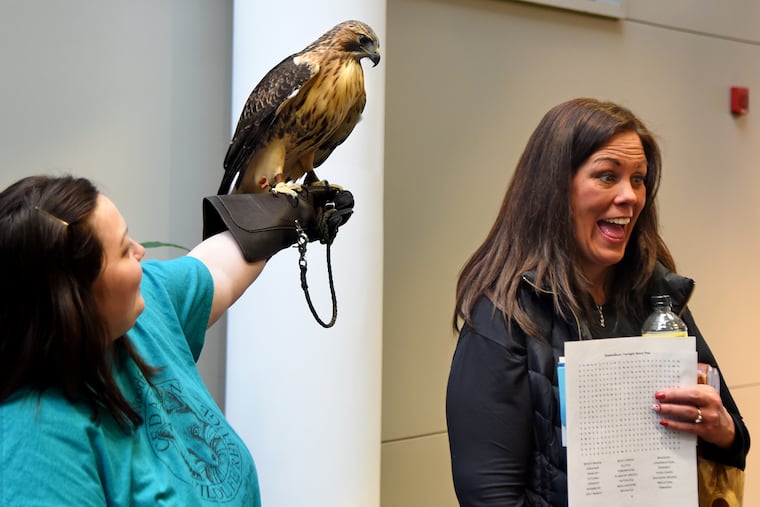New Jersey Pinelands lovers savor the place, the people and ‘the Pineyness’
Big crowds attended Lines on the Pines, the annual celebration of all things "Piney" at Stockton University. It was a showcase for locally-made art, music and crafts of all sorts.

“We live on land that’s been in my husband’s family since the 1600s,” said Niki Giberson — shepherd, weaver, and maker of jam from Pinelands blueberries and beach plums.
“It’s a way of life.”
Giberson, of Port Republic, was among nearly 100 vendors at the Lines on the Pines festival Sunday at Stockton University’s Galloway Township campus. The event featured writers, woodworkers, historians, glass artists, claw-hammer banjo players, and a gentleman who crafts Jersey Devil sculptures from pine cones he finds on the forest floor.
“It’s a gathering of what I like to call Pinelands celebrities,” said Linda Stanton, founder and organizer of Lines on the Pines and “a wannabe Piney, along with a lot of other people.”
Said artist and musician Paul Evans Pedersen Jr., who creates “Pine Barrens Diamonds” jewelry from discarded glass-works material he unearths, “There are people in this room who make stuff you’re not going to see anywhere else.”
Besides showcasing Pinelands arts, crafts, and culture — the acoustic lilt of the Groggy Pines duo and the Cranberry Jam trio set a suitably rootsy mood Sunday — the annual event was a networking opportunity for people smitten with the Pinelands, also known as the Pine Barrens, and the hamlets, ghost towns, and rare (or mythological) creatures that make it such a storied place in South Jersey.
“Lines on the Pines is where people of like minds come together, exhibit their talents, and enjoy the camaraderie,” said Paul Schopp, assistant director of the South Jersey Culture and History Center at Stockton.
The Pinelands cast a spell on many “because of the flora and the fauna, which are unique,” said Schopp. “For others, it’s the history or the culture.”
For me, it’s all of the above.
I’d never known that New Jersey had pine trees, much less pine forests, until a college friend from Toms River told me about them in 1975. After I became a South Jersey newspaperman a year later, I began, story by story, to fall in love with the distinctive landscape of the Pinelands — in places almost otherworldly (think sand roads winding through pygmy pines) and in others as lush as a terrarium.
The people are rather fascinating as well, and, sadly, missing from this year’s Lines on the Pines was one of the region’s most beloved champions, R. Marilyn Schmidt, whom I wrote about a couple of years ago. Schmidt saved the landmark Buzby’s general store in Chatsworth in 1998, and wrote two dozen booklets about the folkways and foodways of her adopted homeland. She died on Feb. 26 at age 89.
“Marilyn supported Lines on the Pines from Day One,” said Stanton, a friend of Schmidt’s for 20 years. She toasted Schmidt’s memory at a dinner following the event, but said that out of respect, none of her many publications were made available for sale this year.
In the half-century since John McPhee’s celebrated book The Pine Barrens helped put the place on the map, a 1.1-million acre national reserve to protect the environmentally fragile region and the aquifer beneath it has been established, as well as periodically defended against pipelines, and other intrusions.
And as recreational use of waterways and hiking trails, and development along its fringes, have rendered the region less remote, scholarship about and appreciation for its past has grown.
“There are all sorts of hidden treasures," said Francis Paulsgraf, who counts among them the museum run by the Mullica in the Pines Historical Society, which is housed in a former schoolhouse in the Nesco section of Mullica Township.
The society has 48 members and 600 pieces, many donated by local residents, in its collection. These include haunting photographs of Amotol, the munitions factory town that was demolished not long after World War I.
Amotol was perhaps the last major industrial use of the Pinelands, which in earlier centuries was the home of lumbering, ironworks, and glassmaking.
The people who stayed on in the Pinelands after industry departed "had an ideal of self-sufficiency — to make a living hunting, fishing, and gardening,” said Rutgers University American studies professor Angus Kress Gillespie, the director of the New Jersey Folk Festival.
An appreciation of the distinctive heritage informs a video series, Down the Pines, that Pedersen is creating. Clips were shown on big screens throughout the main exhibit space Sunday. “We’re trying to get backers” to produce enough episodes for the series to be shown on broadcast TV, he said.
The first episode focuses on Giberson, her husband, Gary, and their Swan Bay Folk Art Center in Port Republic, where they raise a herd that currently has 23 sheep, including eight recently born lambs. The couple, who have three daughters, raise the sheep for wool, not for meat, but they do grow much of their own food.
Although she grew up in Princeton, Giberson doesn’t have to settle for being a Piney wannabe. “I married into it all,” she said.